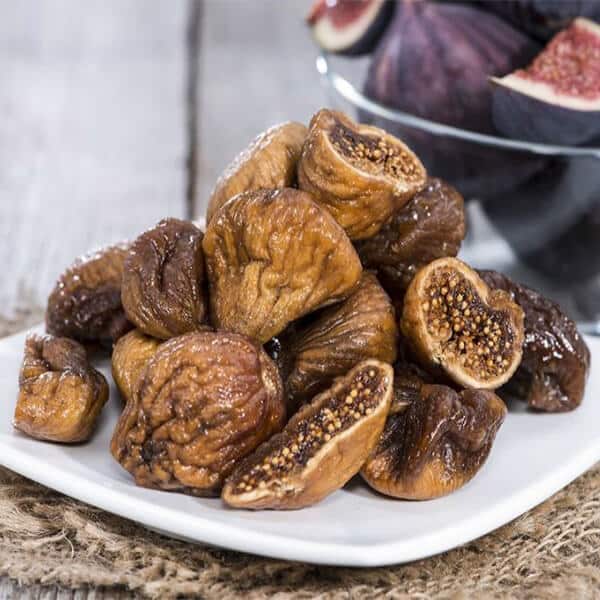The fresh fig is very nutritious, but if you let it dry and lose its water content, not only does it keep longer, but its composition and nutrients are more concentrated, although its caloric intake also increases. And what benefits do dried figs provide? Well, basically the same as the fresh ones, but repowered, in that sense this food provides: an excellent source of energy (they are rich in carbohydrates), high fiber content, high levels of minerals (potassium, magnesium and calcium) and provitamin A. In the kitchen this food also stands out, as it goes very well with game meats and poultry, with salads, with spicy dishes, in pastries, in breads, with exotic food, accompanied by cheeses (aged and cured) and sausages, among others. Delicious and very useful in the kitchen!
Don’t wait any longer, we tell you how to dry figs with different techniques and tricks. You will get an excellent result!
How to dry figs in the oven?
One of the most used home methods to dehydrate food is the oven, as it gives good results, it is hygienic and almost everyone has one. Therefore, it is our first choice. Here we tell you how to dry figs in the oven following the easy step by step:
- Buy fresh and good quality figs. Regardless of the variety, fresh figs should have a firm texture to the touch and an exquisite aroma. Discard all those that have a soft texture or brown spots.
- Don’t wait long to use them. This food is very delicate and even if you refrigerate it, it will remain in good condition for only 3 days, and as that time passes, it will gradually lose organoleptic qualities, for example its flavor will fade.
- Wash the figs thoroughly using plenty of cold water. Handle them with great care, as they are very soft-textured fruits and can easily be damaged or broken. Place them under water and use your thumbs to remove dirt and debris.
- Dry those very well using paper towels or a dry cloth. Roll the figs on the paper or cloth until dry. Remember, does it subtly, because as you already know it is a delicate fruit.
- Remove the stem and cut them. You can cut the figs in half or quarters. If you cut them in half, cut them crosswise from the beginning of the stem to the bottom end. Thanks to this step, the drying process will speed up and you will obtain a more even result.
- Put the figs on a rack and under the rack add a tray. Arrange them leaving 2-3 cm of space between them. Put them with the cut part (the pulp) facing up and avoid piling them on top of each other.
- Preheat oven to 80°C. Have it ready in advance between 10-20 minutes and before introducing the tray lower the temperature.
- Dry the figs in the oven at 50°C and 60°C. That is the ideal temperature, but if your oven does not allow you to have the temperature that low, use the minimum allowed and leaves the door a little ajar.
- Turn the figs every 1-3 hours and check how the drying progresses. You will know that they are ready when they acquire the following characteristics: brown skin, rough and soft texture, but not sticky, in addition, they should not expel internal juices when you squeeze them.
- The drying process will take between 10 and 24 hours. This time ensures that you can keep the product for a long time, since all the moisture has been extracted from the fruit.
- If you want an express method, it may take 2-5 hours. The result will be a product that you should consume in less time, maximum one or two weeks. Of course, the oven starts at 180 °C and is lowered to 80 °C during the process, just when the figs acquire a rough and somewhat sticky texture. From then on, check them every 30 minutes two more times.
- Turn off the oven until cool and leave the figs inside. Then take them out but don’t touch them right away.
- Once cool, store them in a sterilized glass jar. Make sure the container is hermetically sealed and place it in a cool, dry place. And if you’re wondering how to keep dried figs in the oven, keep in mind that some people freeze them in special bags and they can last up to 2 years.
Tip: The fig is not a fruit, but several flowers inverted inside a pod.
How to dry figs in the microwave?
The microwave is the express method par excellence and the ideal option for beginners who want to know how to dry figs. However, this technique does not always guarantee the most optimal result, which is why it is not the most recommended. In any case, if you want to know a quick and acceptable result to dry figs in the microwave follow the step by step:
- Wash the figs very well and remove the stem. Then cut them in half crosswise or in wedges.
- Arrange them on a plate with the pulp facing up. You should never stack the fruit you want to dehydrate, as the air must circulate between the pieces. Therefore, place only 3 figs in each batch (already cut), and leave space between them.
- Dry the figs for 10 minutes. Put the maximum microwave power.
- After the time, remove the plate with an oven mitt or a cloth. After placing the plate in a safe place, turn the figs over.
- Dehydrate the figs for another 10 minutes. After the first 5 minutes, pause and check the development of the process. If you notice that the figs are getting much wrinkled in texture, skip the above time and continue dehydrating for just 2-3 more minutes.
- Place figs on wire rack 30 minutes or until cool. Pass them there with the help of a spatula.
- Once cold, put them in a special zippered bag for refrigerating food. Close it hermetically, put it in another similar bag and closes it too.
- Store the bag in the fridge for 2 days. When the time is up, remove the bag, open it, get as much air out of it as you can, and close it again. The idea is to mimic a vacuum seal.
- Store the bag in the refrigerator again, this time for 3 weeks. After that time, the figs will be completely dry and you can consume them.
How to dry fresh figs in the sun?
If you have a place outdoors and in a warm climate, you can learn how to dry figs naturally, as it is a very effective ancestral method, and today many people continue to apply it. Wondering how to dry sun dried figs. Follow the instructions that we provide below:
- Wash and cut the figs. If the figs are already somewhat dry, it is better to leave them whole, otherwise cut them in half (they are commonly cut in two at the top without separating the halves at the bottom) or in quarters.
- Place them on a rack or some similar utensil. If you don’t have anything similar, you can build a kind of screen printing frame made with boards and a mosquito net or mesh. And if not as a last option, you can use some trays and line them with the cloth that is used to filter the whey from the cheese.
- Arrange the figs so there is space between them. This way the air will circulate better and facilitate drying. Place them with the pulp facing up.
- Arrange the grids on a dry place that receives direct sunlight. Remember the figs must be ventilated very well, that is, the air must enter it from all sides (below, above, and between them). For this reason, place the grills so that they do not cover any of the ventilated areas, it could be on some bricks between the backs of two chairs or in any other ingenious way you can think of.
- Cover them to prevent insects from landing on the figs. Use for this other equal grids or white mosquito net fabric (any other breathable fabric will also work).
- Turn the figs 2-4 times a day. This way the drying will be more even.
- Store the racks indoors overnight. In this way, you will protect the figs from night humidity that could affect the dehydration process. Remember; leave the racks covered, just like you do during the day, and the next morning, turn the figs before exposing them to the sun.
- The drying process can take approximately 1-4 days. There is no exact time because it can vary depending on the temperature and humidity of the place. For this reason, it is recommended to carry out drying in seasons that have many hot and dry days.
- The drying process can take approximately 1-4 days. There is no exact time because it can vary depending on the temperature and humidity of the place. For this reason, it is recommended to carry out drying in seasons that have many hot and dry days.
- Pack in a sterilized jar. Drying time is over. You can now package or consume the product. However, an additional treatment is traditionally applied to ensure the results, we will detail it below.
- Dry the figs in the oven at a temperature of 80ºC (optional). Leave them there for 2 hours, then turn off the oven and wait another 24 hours before taking them out.
- Blanch them 3 times in a row in boiling water (optional). Dip them very briefly in just seconds. Drain them and let them dry very well before packing them hermetically.
Other ways to dry figs
You have already seen what are the most common ways to dehydrate food, but there are many more. It is always good to know them, because some of them can be better adapted to your needs. With that said, let’s look at more options to learn how to dry figs:
- Domestic or industrial dehydrating machines. These are electrical appliances made to dry food. The drying time can vary depending on the power of the dehydrator, although compared to other techniques; it is considerably reduced, since on some occasions food can be dried in 2-4 hours. In addition, this process does not depend on the weather, the result is guaranteed.
- Homemade dehydrators. These are home-made boxes designed to be exposed directly to the sun, therefore, they depend on the weather. In addition, they protect food from external elements, which is why it is more hygienic than the traditional natural method.



